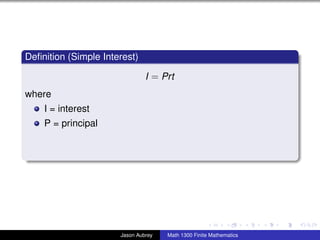
In those cases, judgement will be required in assessing whether the contractual cash flows are consistent with a basic lending arrangement.
#INTEREST AND PRINCIPAL DEFINITION FULL#
However, in other cases the interest rate may change as a result of a future contingent event, or the lender may have full discretion to vary the interest rate charged during the term of a loan (with the borrower having an option to prepay the loan without penalty if it does not wish to accept the new rate). In those circumstances, it may be possible to conclude without significant analysis that the cash flows meet the SPPI Test. Where the bank has published interest rate that apply across a range of products that it offers to its customers, those rates will often be driven by general market interest rates and may be linked to specified benchmark interest rates. It is common for lending arrangements to contain clauses which permit the lending bank to adjust the interest rate charged. IFRS 9 states that in concept, instruments which are not loans and receivables in legal form still might pass the SPPI test.įood for thought – Linked interest contractual cash flows
#INTEREST AND PRINCIPAL DEFINITION PLUS#
As a general rule, loans and receivables that require only fixed payments on fixed dates, or only fixed and variable payments where the amount of the variable payment for a period is determined by applying a floating market rate of interest for that period (e.g., the BA rate, the prime rate, or LIBOR) plus a fixed spread to a specified reference amount (such as a stated maturity amount) will have payments that meet the SPPI test. IFRS 9 provides general guidance, discussed below, to assist in this evaluation. Ordinarily, it should be possible to establish this by considering the nature of the lender’s rights to cash flows, and the cash flows risks and volatility to which the lender is exposed. The objective of the SPPI test is to determine whether an arrangement pays only interest and principal, as defined, not to quantify their respective amounts. Solely Payments of Principal and Interest Food for thought – Objective of the Solely Payments of Principal and Interest Test profit margin is maintained) then the inclusion of these elements are consistent with a basic lending arrangement. If the lending arrangement includes a clause that compensates the lender for these other elements and they do not result in a change in the nature of the lending arrangement (i.e. Whilst the consideration for the time value of money and credit risk are typically the most significant elements of ‘ interest’, IFRS 9 acknowledges that it can also contain other elements such as consideration for liquidity risk, profit margin and service or administrative costs. Solely Payments of Principal and Interest

IFRS 9 defines principal as the fair value of a financial asset at initial recognition, which may change over the life of a financial instrument (for example, if there are repayments of principal). the contractual cash flows are consistent with a basic lending arrangement). Meaning of principal and interest in Solely Payments of Principal and Interestīecause it is a test it is important to get right what the meaning of principaland interest is.Ĭontractual cash flows are considered to be SPPI if the contractual terms of the financial asset only give rise to cash flows that are solely payments of principal and interest on the principal amount outstanding on specified dates (i.e. Instruments that fail this test are classified and measured at FVPL. We discuss the key aspects the SPPI test below. Here is the decision tree to obtain an easy overview: Solely Payments of Principal and Interest Test
/dotdash_Final_Simple_Interest_vs_Compound_Interest_Whats_the_Difference_Dec_2020-01-e85d09211a9c4fe3a0290140a1a1ccdb.jpg)

The contractual cash flows of the asset (the SPPI test, yes that’s the one discussed here).



 0 kommentar(er)
0 kommentar(er)
